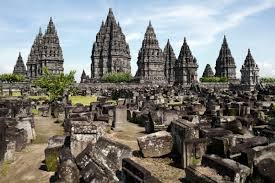Prambanan Temple: A Majestic Hindu Legacy in Central Java
Prambanan Temple: A Majestic Hindu Legacy in Central Java

Prambanan Temple, also known as the Rara Jonggrang Temple, is a stunning example of Hindu architecture and one of Indonesia's most significant cultural and historical landmarks. Situated in Central Java, near the city of Yogyakarta, this UNESCO World Heritage site is the largest Hindu temple complex in Indonesia and one of the largest in Southeast Asia. The temple’s intricate architecture, towering spires, and detailed relief carvings make it a remarkable testament to the grandeur of ancient Javanese civilization and Hindu religious traditions. As a symbol of Indonesia’s rich cultural heritage, Prambanan continues to captivate visitors with its historical significance, breathtaking beauty, and spiritual importance.
Historical Background of Prambanan Temple
prambanan temple was built during the 9th century under the rule of the Sanjaya Dynasty, a Hindu dynasty that ruled over much of Java. The temple complex was constructed between 850 CE and 860 CE by King Rakai Pikatan and later expanded by his successor, King Balitung. The temple was dedicated to the Hindu trinity of Brahma, Vishnu, and Shiva, with the largest and central temple being dedicated to Shiva. It is believed that Prambanan served not only as a place of worship but also as a symbol of the power and influence of the Sanjaya Dynasty.
The history of the temple complex, however, is not without its challenges. Like many ancient sites in the region, Prambanan fell into neglect and was abandoned after the decline of Hinduism in Java. The shift towards Buddhism and the rise of Islam in the region led to the gradual disintegration of Hindu temples, including Prambanan. By the 16th century, the temple complex had been largely abandoned, and it was buried under volcanic ash from the nearby Merapi volcano.
It wasn’t until the 19th century that Prambanan was rediscovered, during the Dutch colonial period. Extensive restoration work began in the 1930s and has continued into the present day. The temple complex is now one of the most important tourist destinations in Indonesia, drawing visitors from all over the world to witness its historical and cultural significance.
Architectural Design of Prambanan Temple
Prambanan Temple is an architectural marvel, known for its towering spires, symmetrical layout, and intricate carvings. The temple complex consists of over 240 temples, although only a fraction of these have been restored and are accessible to the public today. The centerpiece of the Prambanan complex is the three main temples, each dedicated to one of the Hindu trinity gods: Shiva, Vishnu, and Brahma. These temples are surrounded by smaller shrines dedicated to various other deities in the Hindu pantheon.
The layout of Prambanan follows the traditional Hindu temple architecture, with the design intended to represent the cosmic mountain, Meru, which in Hinduism is the center of the universe. The central temple of Shiva, the largest of the three main temples, stands at 47 meters (154 feet) tall and is the focal point of the complex. The temples of Vishnu and Brahma, located to the north and south of Shiva’s temple, are slightly smaller but equally impressive in their design.
The temple’s spires, or meru, are designed to point towards the heavens, symbolizing the connection between the divine and the earthly realm. The intricate carvings on the temples are another striking feature of the complex. The reliefs on the temples depict scenes from Hindu mythology, including stories from the Ramayana and the Mahabharata, two of the most important epics in Hindu tradition.
One of the most notable features of Prambanan is its intricate stone reliefs, which are carved in bas-relief on the walls of the temples. These reliefs depict the story of Ramayana, the epic tale of the prince Rama’s quest to rescue his wife Sita from the demon king Ravana. The Ramayana is one of the most important texts in Hinduism and is frequently depicted in Hindu temples across India and Southeast Asia. The reliefs at Prambanan follow the story closely, with panels showing the key episodes of the epic, including Rama’s battle with Ravana, his alliance with the monkey king Hanuman, and his eventual victory.
The artistic precision and detail of the reliefs are a testament to the advanced craftsmanship of the builders. The reliefs are arranged in a way that allows visitors to trace the progression of the Ramayana from beginning to end as they move around the temple, creating an immersive storytelling experience.
Religious Significance of Prambanan Temple
Prambanan Temple, like many Hindu temples, is not only an architectural feat but also a deeply spiritual place. The complex was built as a center for the worship of the Hindu gods, particularly Shiva, the god of destruction and regeneration, who is represented by the central temple. The temple complex reflects the Hindu belief in the cycle of creation, preservation, and destruction, with the three primary deities—Brahma (the creator), Vishnu (the preserver), and Shiva (the destroyer)—working together to maintain cosmic balance.
In addition to its religious significance, prambanan temple also served as a symbol of the power and influence of the Sanjaya Dynasty, which sought to establish its authority over the region through the construction of grand religious monuments. The temple complex was intended to glorify the divine and reinforce the legitimacy of the rulers who built it.
For Hindus, the temple remains a place of spiritual significance. Pilgrims and worshippers visit Prambanan to pray, make offerings, and seek blessings from the deities. The temple complex is still used for religious ceremonies and festivals, particularly during the annual Kuningan festival, a celebration of the Hindu gods.
What's Your Reaction?













